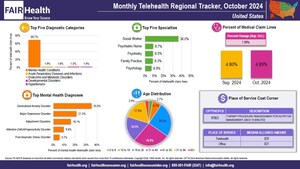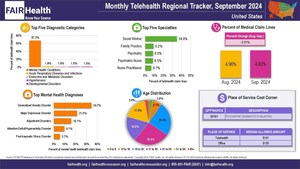Lyme Disease Most Common in the Age Group 51-60 in the Period 2018-2022
Malaise and Fatigue and Soft-Tissue-Related Diagnoses Were Generally More Common in Lyme Disease Patients Than All Patients, according to FAIR Health Study
NEW YORK, Oct. 17, 2023 /PRNewswire/ -- In the period 2018-2022, more Lyme disease claim lines were filed for individuals in the 51-60 age group than any other group, according to an infographic based on private insurance claims and released today by FAIR Health.1 Individuals aged 51 to 60 accounted for 23.5 percent of Lyme disease claim lines, compared to 18.8 percent in the next largest age group, 41-50. The remaining age groups studied, with their percentages of Lyme disease claim lines, were 31-40 (14.1 percent), 19-30 (14.0 percent), 61-70 (13.9 percent), 0-18 (11.3 percent) and over 70 (4.3 percent).
These and other findings on this tick-borne, bacterial illness were drawn from the national, independent nonprofit organization FAIR Health's database of over 42 billion privately billed healthcare claim records, the largest such repository in the nation. Among the other key findings:
- To identify later diagnoses associated with Lyme disease, FAIR Health examined a statistically significant cohort of individuals from 2018 to 2022, comparing the prevalence of certain diagnoses among Lyme patients to all patients in the cohort. The analysis found that, across all age groups except those over 80, malaise and fatigue and soft-tissue-related diagnoses were more common among Lyme patients than among the total patient population.
- The prevalence of Lyme disease varies by time of year when comparing rural and urban areas. From 2018 to 2022, claim lines with Lyme disease diagnoses peaked nationally in June and July of each year. During these summer months, rural areas, on average, had a greater share of claim lines associated with Lyme disease diagnoses than urban areas. From November to April, however, claim lines with Lyme disease diagnoses occurred more often in urban than rural areas.
- In 2018, the states with the greatest proportion of claim lines with Lyme disease diagnoses as a percentage of all diagnoses in the state, from highest to lowest, were New Jersey, North Carolina, Rhode Island, Connecticut and Massachusetts.
- By contrast, in 2022, the top Lyme disease states, from highest to lowest, were New Jersey, Vermont, Connecticut, Pennsylvania and Rhode Island. North Carolina and Massachusetts dropped off the list, and Vermont and Pennsylvania joined the list. Connecticut rose from fourth to third place, and Rhode Island fell from third to fifth place.
FAIR Health President Robin Gelburd stated, "Lyme disease remains a pressing public health concern. FAIR Health will continue to use its repository of claims data to provide actionable and relevant insights to healthcare stakeholders seeking to better understand this disease."
To view the infographic, click here.
Follow us on Twitter @FAIRHealth
About FAIR Health
FAIR Health is a national, independent nonprofit organization that qualifies as a public charity under section 501(c)(3) of the federal tax code. It is dedicated to bringing transparency to healthcare costs and health insurance information through data products, consumer resources and health systems research support. FAIR Health possesses the nation's largest collection of private healthcare claims data, which includes over 42 billion claim records and is growing at a rate of over 2 billion claim records a year. FAIR Health licenses its privately billed data and data products—including benchmark modules, data visualizations, custom analytics and market indices—to commercial insurers and self-insurers, employers, providers, hospitals and healthcare systems, government agencies, researchers and others. Certified by the Centers for Medicare & Medicaid Services (CMS) as a national Qualified Entity, FAIR Health also receives data representing the experience of all individuals enrolled in traditional Medicare Parts A, B and D; FAIR Health includes among the private claims data in its database, data on Medicare Advantage enrollees. FAIR Health can produce insightful analytic reports and data products based on combined Medicare and commercial claims data for government, providers, payors and other authorized users. FAIR Health's systems for processing and storing protected health information have earned HITRUST CSF certification and achieved AICPA SOC 2 Type 2 compliance by meeting the rigorous data security requirements of these standards. As a testament to the reliability and objectivity of FAIR Health data, the data have been incorporated in statutes and regulations around the country and designated as the official, neutral data source for a variety of state health programs, including workers' compensation and personal injury protection (PIP) programs. FAIR Health data serve as an official reference point in support of certain state balance billing laws that protect consumers against bills for surprise out-of-network and emergency services. FAIR Health also uses its database to power a free consumer website available in English and Spanish, which enables consumers to estimate and plan for their healthcare expenditures and offers a rich educational platform on health insurance. An English/Spanish mobile app offers the same educational platform in a concise format and links to the cost estimation tools. The website has been honored by the White House Summit on Smart Disclosure, the Agency for Healthcare Research and Quality (AHRQ), URAC, the eHealthcare Leadership Awards, appPicker, Employee Benefit News and Kiplinger's Personal Finance. FAIR Health also is named a top resource for patients in Dr. Elisabeth Rosenthal's book An American Sickness: How Healthcare Became Big Business and How You Can Take It Back. For more information on FAIR Health, visit fairhealth.org.
Contact:
Rachel Kent
Senior Director of Communications and Marketing
FAIR Health
646-396-0795
[email protected]
1 A claim line is an individual service or procedure listed on an insurance claim.
SOURCE FAIR Health

WANT YOUR COMPANY'S NEWS FEATURED ON PRNEWSWIRE.COM?
Newsrooms &
Influencers
Digital Media
Outlets
Journalists
Opted In






Share this article